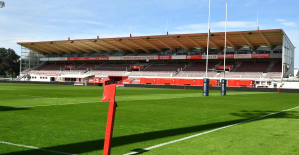The discussion about a continuation of the 9-euro ticket for buses and trains goes past a large number of citizens in Germany. For 14 million people in rural areas, public transport is not an alternative to the car because there is a lack of the corresponding offer. This is shown by a new evaluation by Agora Verkehrswende, an organization that is financed by climate protection foundations, among others.
"For 52 percent of the population, public transport runs at most every hour - for 17 percent even less than every two hours," says the "ÖV-Atlas", the current version of which Agora has now published. According to the authors, the second group, which includes around 14 million people, is dependent on private cars.
While the traffic light coalition in Berlin is discussing whether there should be a follow-up offer for the nationwide valid 9-euro ticket for regional transport, the traffic change lobbyists point out that the supply of public transport in Germany is very different. They rate it as “good supply” if “during peak traffic times a bus or train leaves the surrounding bus stops on average at least every 15 minutes”.
According to the evaluation, 30 percent of citizens in Germany can use such an offer. The calculations are based on 500 million timetable data from all over Germany, which are collected in a public database called Delfi (“continuous electronic passenger information”). Almost all transport associations have been posting their plans there since this year, and there are only a few gaps in the data.
There are differences in public transport not only between town and country, but also between comparable rural regions. In order to make this clear, the authors of the study put the bus and train connections in relation to the number of inhabitants on the one hand and form values in relation to the built-up area (settlements and traffic area) on the other hand - forests, lakes or fields are not included.
From this they determine the "trip density", a value that shows how well a region is supplied with public transport. If one now compares these values of similarly sparsely or densely populated districts, then a statement can be made about the quality of the offer.
Result: In Saarland, in large parts of Saxony and Baden-Württemberg, there is an above-average good connection to buses and trains. Thuringia, Saxony-Anhalt, large parts of Lower Saxony, Bavaria and the east of Mecklenburg-Western Pomerania, on the other hand, are poorly served by public transport. Those 14 million people live in these regions who cannot be mobile without a private car.
The big cities are naturally at the top of the scale: Munich leads in terms of "trip density" ahead of Frankfurt and Berlin, followed directly by Bonn. Hamburg is only in eighth place because the frequency south of the Elbe is less frequent than in the north due to the lack of subways. "In many large cities, it can be observed how a good public transport offer on the outskirts suddenly ends and is already considerably worse in the immediate commuter belt," write the authors.
Does more supply mean that drivers switch to buses and trains? "In cities where buses and trains run at least every 10 minutes, typically more than a quarter of the transport performance is covered by public transport," the authors write.
However, they have to admit that there is no "rigid connection between supply and demand". Frankfurt/Main, Berlin and Heidelberg are all far ahead when you compare the number of journeys to the built-up area.
While the residents of the capital use public transport for 42 percent of their journeys, the figure in the other two cities is significantly less than 30 percent. Augsburg and Kiel – almost the same in terms of “journey density” – are also very far apart when it comes to the use of buses and trains: more than 30 percent in the Bavarian city compared to less than 15 percent on the Förde. The supply alone does not create the demand.
"Everything on shares" is the daily stock exchange shot from the WELT business editorial team. Every morning from 7 a.m. with our financial journalists. For stock market experts and beginners. Subscribe to the podcast on Spotify, Apple Podcast, Amazon Music and Deezer. Or directly via RSS feed.

 United States: divided on the question of presidential immunity, the Supreme Court offers respite to Trump
United States: divided on the question of presidential immunity, the Supreme Court offers respite to Trump Maurizio Molinari: “the Scurati affair, a European injury”
Maurizio Molinari: “the Scurati affair, a European injury” Hamas-Israel war: US begins construction of pier in Gaza
Hamas-Israel war: US begins construction of pier in Gaza Israel prepares to attack Rafah
Israel prepares to attack Rafah Spain is the country in the European Union with the most overqualified workers for their jobs
Spain is the country in the European Union with the most overqualified workers for their jobs Parvovirus alert, the “fifth disease” of children which has already caused the death of five babies in 2024
Parvovirus alert, the “fifth disease” of children which has already caused the death of five babies in 2024 Colorectal cancer: what to watch out for in those under 50
Colorectal cancer: what to watch out for in those under 50 H5N1 virus: traces detected in pasteurized milk in the United States
H5N1 virus: traces detected in pasteurized milk in the United States Private clinics announce a strike with “total suspension” of their activities, including emergencies, from June 3 to 5
Private clinics announce a strike with “total suspension” of their activities, including emergencies, from June 3 to 5 The Lagardère group wants to accentuate “synergies” with Vivendi, its new owner
The Lagardère group wants to accentuate “synergies” with Vivendi, its new owner The iconic tennis video game “Top Spin” returns after 13 years of absence
The iconic tennis video game “Top Spin” returns after 13 years of absence Three Stellantis automobile factories shut down due to supplier strike
Three Stellantis automobile factories shut down due to supplier strike A pre-Roman necropolis discovered in Italy during archaeological excavations
A pre-Roman necropolis discovered in Italy during archaeological excavations Searches in Guadeloupe for an investigation into the memorial dedicated to the history of slavery
Searches in Guadeloupe for an investigation into the memorial dedicated to the history of slavery Aya Nakamura in Olympic form a few hours before the Flames ceremony
Aya Nakamura in Olympic form a few hours before the Flames ceremony Psychiatrist Raphaël Gaillard elected to the French Academy
Psychiatrist Raphaël Gaillard elected to the French Academy Skoda Kodiaq 2024: a 'beast' plug-in hybrid SUV
Skoda Kodiaq 2024: a 'beast' plug-in hybrid SUV Tesla launches a new Model Y with 600 km of autonomy at a "more accessible price"
Tesla launches a new Model Y with 600 km of autonomy at a "more accessible price" The 10 best-selling cars in March 2024 in Spain: sales fall due to Easter
The 10 best-selling cars in March 2024 in Spain: sales fall due to Easter A private jet company buys more than 100 flying cars
A private jet company buys more than 100 flying cars This is how housing prices have changed in Spain in the last decade
This is how housing prices have changed in Spain in the last decade The home mortgage firm drops 10% in January and interest soars to 3.46%
The home mortgage firm drops 10% in January and interest soars to 3.46% The jewel of the Rocío de Nagüeles urbanization: a dream villa in Marbella
The jewel of the Rocío de Nagüeles urbanization: a dream villa in Marbella Rental prices grow by 7.3% in February: where does it go up and where does it go down?
Rental prices grow by 7.3% in February: where does it go up and where does it go down? Even on a mission for NATO, the Charles-de-Gaulle remains under French control, Lecornu responds to Mélenchon
Even on a mission for NATO, the Charles-de-Gaulle remains under French control, Lecornu responds to Mélenchon “Deadly Europe”, “economic decline”, immigration… What to remember from Emmanuel Macron’s speech at the Sorbonne
“Deadly Europe”, “economic decline”, immigration… What to remember from Emmanuel Macron’s speech at the Sorbonne Sale of Biogaran: The Republicans write to Emmanuel Macron
Sale of Biogaran: The Republicans write to Emmanuel Macron Europeans: “All those who claim that we don’t need Europe are liars”, criticizes Bayrou
Europeans: “All those who claim that we don’t need Europe are liars”, criticizes Bayrou These French cities that will boycott the World Cup in Qatar
These French cities that will boycott the World Cup in Qatar Archery: everything you need to know about the sport
Archery: everything you need to know about the sport Handball: “We collapsed”, regrets Nikola Karabatic after PSG-Barcelona
Handball: “We collapsed”, regrets Nikola Karabatic after PSG-Barcelona Tennis: smash, drop shot, slide... Nadal's best points for his return to Madrid (video)
Tennis: smash, drop shot, slide... Nadal's best points for his return to Madrid (video) Pro D2: Biarritz wins a significant success in Agen and takes another step towards maintaining
Pro D2: Biarritz wins a significant success in Agen and takes another step towards maintaining


















